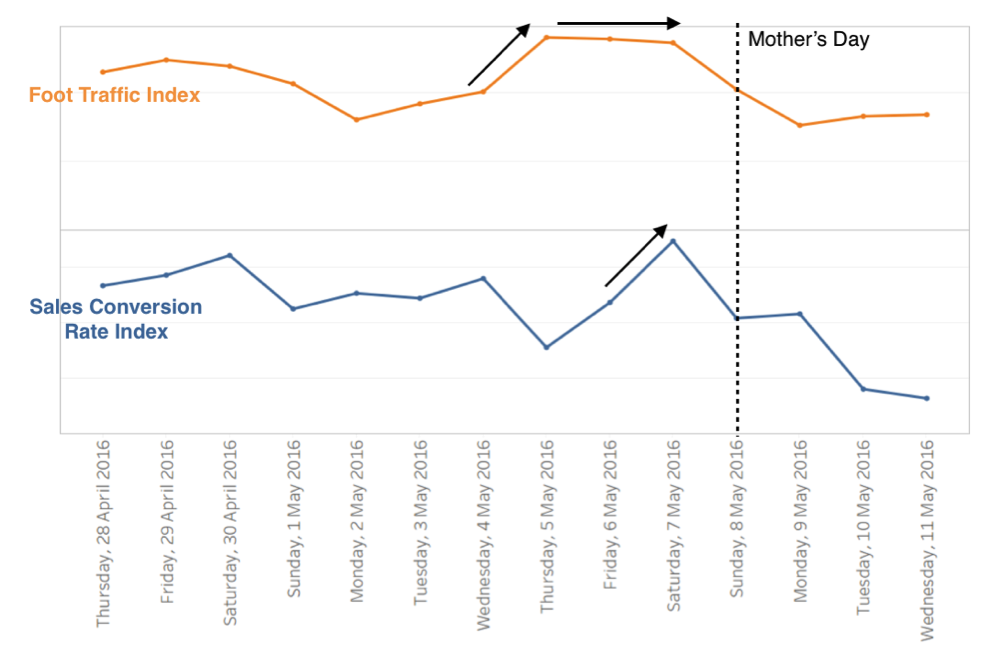Kepler Analytics Radar
The Kepler Radar™ is a publication providing information, analysis and comment on retail trends and consumer behavior using aggregate Kepler measures as the basis. Kepler Radar is published on a monthly basis and the subject matter will relate to market dynamics.
Retailers have always had sales data to measure the impact of ANZAC Day and Mother’s Day on store performance. However, we were able to gain additional insights into customer behaviour by observing industry level foot traffic data (specialty retail sector in Australia) on the days leading up to these public holidays.
1.1 Key observations for ANZAC Day 2016 and 2017:
- ANZAC Day 2016 fell on a Monday and in 2017 fell on a Tuesday.
- The weekend before each ANZAC Day generally performed similarly to a standard weekend.
- Due to shorter opening hours, total transactions on ANZAC Day were lower than a standard Monday or Tuesday. However, hourly transactions were on average 30% higher.
- Higher hourly sales were driven by a 35% increase in hourly traffic and a remarkably stable sales conversion rate (Figure 1.1).
 Figure 1.1 SALES CONVERSION RATE INDEX ON ANZAC DAY 2017 TUESDAY AND THE FIVE TUESDAYS BEFORE.
Figure 1.1 SALES CONVERSION RATE INDEX ON ANZAC DAY 2017 TUESDAY AND THE FIVE TUESDAYS BEFORE.
1.2 Key insights for ANZAC Day:
- There is an opportunity to increase rosters during ANZAC Day to capture more sales.
- Any promotional activity should focus primarily on ANZAC Day itself as there is no change in shopper behaviour during the weekend before and days leading up to the public holiday.
- Shoppers have demonstrated a high willingness-to-buy during ANZAC Day and there could be an opportunity to minimise price promotions on the day to increase the average transaction value.
2.1 Key observations for Mother’s Day 2016:
- On the days leading up to Mother’s Day 2016, there was a large sales driven spike by a surge in foot traffic and sales conversion rates on the Saturday before Mother’s Day Sunday (Figure 2.1).
- However, foot traffic began to surge on Thursday and Friday, reaching Saturday levels. This surge was not accompanied by an increase in sales conversion rates (Figure 2.1).
It indicates that a large number of shoppers began browsing for gifts on Thursday and Friday, with the final purchase decision being made on Saturday.
 Figure 2.1 SALES CONVERSION RATE AND FOOT TRAFFIC INDEX BEFORE AND AFTER MOTHER’S DAY 2016.
Figure 2.1 SALES CONVERSION RATE AND FOOT TRAFFIC INDEX BEFORE AND AFTER MOTHER’S DAY 2016.
2.2 Key insights for Mother’s Day:
- While sales may only spike on the Saturday before Mother’s Day Sunday, retailers have the opportunity to engage with a large volume of shoppers starting on Thursday and Friday. Retailers should consider increasing rosters for the days leading up to Mother’s Day to increase sales conversion rate or at least try to capture prime shoppers to convert into a sale on Saturday.
- There is also an opportunity to design promotional activity around converting shoppers on Thursday and Friday. Capturing the unconverted shoppers on Thursday and Friday will not only help increase sales revenue, but also enhance business competitiveness in the industry. Once these shoppers are converted there is a lower likelihood of them transacting with a competitor on the Saturday where most of the final purchase decisions traditionally occur.
Miley He is a Lead Data Scientist with Kepler Analytics Pty Ltd and can be contacted using the Kepler contact details.
David Gordon
0412 32 48 49
david.gordon@kepleranalytics.com

